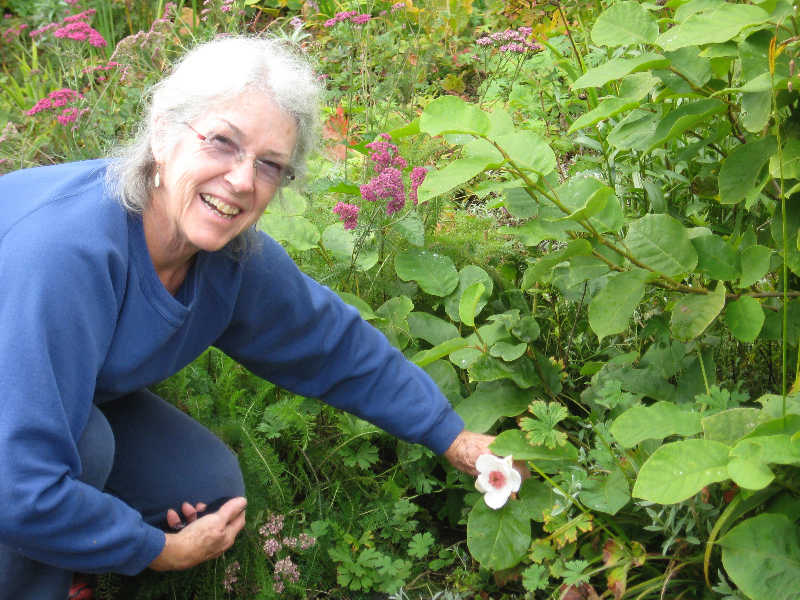A magnolia in bloom right here at latitude 59 degrees 39 minutes north. Now that’s something to write home about. Well-known Homer gardener Shirley Forquer can do just that. She acquired her plant 12 or 15 years ago in Port Townsend, Wash., gave it a home and then forgot about it, more or less. Three weeks ago she noticed something white on the ground near the base of the plant and, lo, a bloom.
Should we all run out and plant magnolias? I, for one, don’t have Shirley’s patience. But there is more at work here. Climate change is moving fast here in the Far North and we gardeners need to be taking advantage of the positive effects it has to offer us.
There are minds far greater than mine out there that have yet to do anything to call a halt to this pending disaster. So, I say, let’s roll with it. Take chances and plant what you would normally consider too tender for our zone (2, 3 or 4, depending on your elevation and microclimate — this whole business is tricky). You have all winter to think about this — if we have a winter.
In the meantime, keep weeding. Everywhere I look the grass is more gorgeous than I have ever seen it, and it is invading my perennial beds. I do believe grass is our most invasive plant species. Get out there and take a look, you will undoubtedly find something that needs to be pulled. This goes for the annuals that you have left in the beds. They have sown their seeds for next year and are now looking tatty. Out they go. You will be impressed how tidy your beds will look once you remove spent plants. Toss them into the compost.
As you harvest your vegetables you’ll notice there is more waste to the plants than food, again — the compost is where all of that belongs. Chop up the pieces with a machete, the smaller the chunks the quicker it will decompose.
Now is the time to spread pelleted lime on the vegetable patch if it needs it. This is garden lime and is not powdered, making it easier to handle. There are those of you who have their soil tested. I think now is the time to get this done, don’t wait for spring. If your garden needs lime (I know mine does every few years) it takes time for it to become effective. It can have all winter to break down and be of use to the plants come spring. If you don’t, test smell your soil instead or even taste it. If you detect sourness, a little lime will go a long way.
I have discovered black currants. Up to this summer the only thing I have known about them is they are moose magnets. Hence I have stayed away from them. But the logic took over — my entire garden is a moose magnet what’s one more? Besides we love black currants so there is now a new shrub installed near the greenhouse. They are easy to propagate so if one isn’t enough there could be more in my future. We’ll see. The ideal rainy day includes fresh bread with butter, black currant jam and a cup of tea.
We went to the Arctic Circle via the Dempster Highway and were gone for a week. There really is nothing like being gone to notice how much everything grew in the absence. The William Baffin roses have gone wild. Everything went wild. The clematis are all growing three inches a day, A DAY. Good grief. The concern here is if we actually get cold and the tender new growth is damaged. These are the chances we gardeners take. Goodness.
I’m getting close to planting garlic. Last year it went into the ground Sept. 21 and I fussed and fretted about it all fall. I worried it was all rotting, the rain was determined, intense and garlic does not like that, no, not at all. Then to top it off it sprouted and went into the winter almost two inches tall. I called my brother in Central New York where garlic is a cash crop and he assured me it would survive just fine. Oh, how I doubted, but there it was this spring, fit as a fiddle and I now have the robust scent of garlic perfuming the basement where it is successfully curing.
The Copra onions have joined the garlic and shallots. Believe me, our basement smells great. As the ground freezes (if the ground freezes), I’ll toss on a few spruce boughs and call it good. There is no comparison to homegrown garlic, onion and shallots to what the store offers. Think about this.
The greenhouse is almost empty. We replace the compost every fall; wash the bins and walls; have everything ready for spring. Come April the only thing to do is throw the switch on the heater. Bliss.
This also is the time to get your diagram for next year’s vegetable plot. Note where you will plant what, where you already planted the garlic so you know where it is. You get the idea — plan, it makes life easier.
Keep gardening.
Rosemary Fitzpatrick is a longtime Homer gardener. She has been writing the Kachemak Gardener since 1990.


